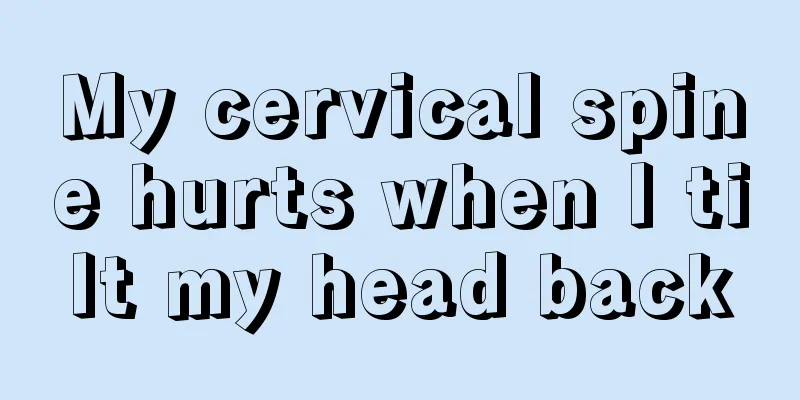My cervical spine hurts when I tilt my head back

|
With the pressure of study, work, etc., many people keep their heads down for a long time, and when they suddenly look up, they will have a headache. Sometimes, even if they don’t lower their heads, their cervical spine will hurt when they tilt their heads back. This is a very obvious cervical spondylosis. If you do not take care of yourself and pay attention, the condition will become more and more serious, and you will also experience dizziness, numbness in the arms, etc. You must learn to self-regulate. Cervical spondylosis, also known as cervical spondylosis, is a general term for cervical osteoarthritis, hypertrophic cervical spondylitis, cervical radiculitis, and cervical disc herniation. It is a disease based on degenerative pathological changes. It is mainly caused by long-term strain of the cervical spine, bone hyperplasia, or herniated disc, ligament thickening, which leads to compression of the cervical spinal cord, nerve roots or vertebral arteries, resulting in a series of clinical syndromes of functional disorders. It manifests as vertebral instability and loosening; nucleus pulposus protrusion or extrusion; bone spur formation; ligament hypertrophy and secondary spinal canal stenosis, etc., which stimulate or compress adjacent nerve roots, spinal cord, vertebral arteries, cervical sympathetic nerves and other tissues, causing a series of symptoms and signs. Causes 1. Degeneration of the cervical spine Degenerative changes of the cervical spine are the main cause of cervical spondylosis, among which the degeneration of the intervertebral disc is particularly important and is the primary factor in the degeneration of the cervical spine structures. From this, a series of pathological anatomical and pathophysiological changes of cervical spondylosis have evolved. ① Degeneration of the intervertebral disc; ② The appearance of the ligament-disc space and hematoma formation; ③ The formation of bone spurs on the edge of the vertebral body; ④ Degeneration of other parts of the cervical spine; ⑤ Reduction in the sagittal diameter and volume of the spinal canal. 2. Developmental cervical spinal stenosis In recent years, it has been confirmed that the inner diameter of the cervical spinal canal, especially the sagittal diameter, is closely related not only to the occurrence and development of cervical spondylosis, but also to the diagnosis, treatment, selection of surgical methods and prognosis of cervical spondylosis. Some people have severe cervical degeneration and obvious osteophyte hyperplasia, but they do not develop the disease. The main reason is that the sagittal diameter of the cervical spinal canal is wide and there is a large compensatory space in the spinal canal. For some patients, cervical degeneration is not very serious, but the symptoms appear early and are more severe. 3. Chronic strain Chronic strain refers to various excessive activities that exceed the maximum range of normal physiological activities or the local tolerance value. Because it is different from obvious trauma or accidents in life and work, it is easy to be ignored, but it has a direct relationship with the occurrence, development, treatment and prognosis of cervical spondylosis. The generation and cause of this kind of strain mainly come from the following three situations: (1) Improper sleeping position: An improper sleeping position lasts for a long time and cannot be adjusted in time when the brain is in a resting state, which will inevitably cause imbalance of the paravertebral muscles, ligaments and joints. (2) Improper working posture. A large amount of statistical data shows that the incidence of cervical spondylosis is particularly high among people who do not have a large workload or high intensity work, but are sitting or working with their heads down. These people include houseworkers, embroiderers, office workers, typists, assemblers on instrument assembly lines, etc. (3) Inappropriate physical exercise Normal physical exercise is good for health, but activities or exercises that exceed the neck's tolerance, such as handstands or somersaults with the head and neck as the weight-bearing support points, can increase the load on the cervical spine, especially without proper guidance. 4. Congenital malformation of the cervical spine When performing health examinations or comparative research radiographs on the cervical spine of normal people, various abnormalities are often found in the cervical spine segments, of which obvious bone deformities account for about 5%. |
<<: What should I do if my hand is injured and swollen
>>: I feel sore all over after sleeping_I feel sore all over after waking up
Recommend
What are the blood test indicators for breast cancer
Relevant statistics show that breast cancer ranks...
How to make a stiff body soft
Whether you want to learn dance or want to get be...
Can an 85-year-old man with bile duct cancer undergo surgery?
Whether an 85-year-old with bile duct cancer can ...
B ultrasound is one week larger
Some pregnant women will find out that the fetus ...
Itchy calves in autumn and winter
In autumn and winter, many people will feel that ...
Why is there back pain after being discharged from chemotherapy for ovarian cancer
Why do patients with lower back pain after chemot...
Medicine for tenosynovitis
Tenosynovitis is a common disease nowadays, which...
Are plastic bags harmful?
Plastic bags are a necessity in our daily life. W...
What does neurology do?
There are many departments in the hospital, and e...
Is pacemaker surgery risky?
Pacemakers can not only be used to treat serious ...
How can liver cancer be treated in the early stage to have a chance of recovery? You can choose these four treatments
Patients with early-stage liver cancer can genera...
If you don't do this after washing your underwear, it's a waste of time
It is common sense that everyone knows that under...
Pain in the lower back and joints is an obvious early symptom of liver cancer
The early symptoms of liver cancer are secretive ...
How long does it take to recover after wisdom tooth extraction
It is well known that people aged 18-25 generally...
What should I do about cervical precancerous lesions? What are the symptoms of cervical precancerous lesions?
Cervical cancer is a malignant tumor that serious...









